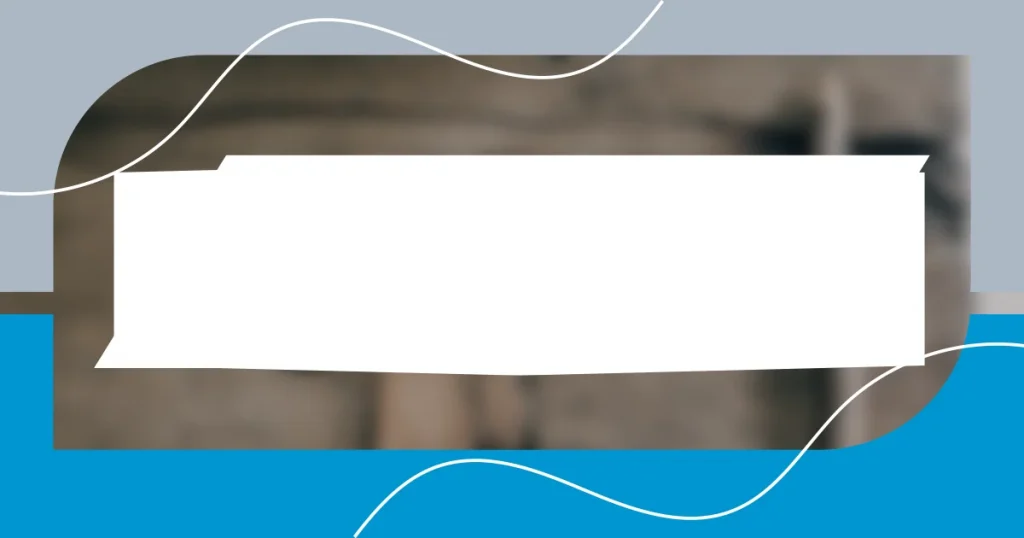Key takeaways:
- Environmental factors such as temperature, humidity, and airflow significantly affect drying times; for example, high heat can warp materials while optimal airflow enhances evaporation.
- Techniques like using fans, dehumidifiers, and applying thinner layers can greatly reduce drying times and improve efficiency.
- Understanding the unique properties of different materials, including their thickness and moisture retention, is essential for effective drying and troubleshooting issues.

Understanding drying times
Understanding drying times can be fascinating, especially when you consider the different factors at play. I remember a time when I impatiently tried to speed up the drying process of a freshly painted canvas. I thought warmth would do the trick, only to discover that high heat actually warped my piece! This experience taught me how crucial the environment—temperature and humidity—can be in determining drying times.
Have you ever noticed how much faster your clothes dry on a sunny day compared to a damp, rainy one? It’s not just you; this is a prime example of how moisture in the air interacts with drying times. I’ve often found it helpful to check the weather before deciding to hang laundry outside. It’s a small tip that can make a big difference, ensuring that I don’t waste time and energy waiting for clothes that might stay damp for hours.
Let’s not overlook the impact of the materials being dried. For instance, when working on woodworking projects, I’ve learned that different types of wood absorb moisture differently, leading to varying drying times. The thrill of watching my pieces come together is often tempered by the wait, making it clear that patience truly pays off in the long run in the crafting world. Each material tells its own drying story, and taking the time to understand those nuances can lead to much better results.

Factors that affect drying times
When it comes to drying times, one factor I can’t stress enough is airflow. I recall a day when I decided to dry my freshly washed curtains indoors. The lack of breeze made them take forever to dry, and I begrudgingly realized that a good flow of air can significantly speed up the process. Ensuring proper ventilation can be a game changer, transforming the mundane task of drying into a quick and efficient one.
Temperature plays a pivotal role too. I once tried using a heater to dry a newly crafted clay project, expecting it to work wonders. Instead, the excessive heat caused cracks in the piece, leading me to understand that a moderate temperature, balanced with patience, is often more effective than trying to rush things. In my experience, it’s always better to let the air do its job naturally rather than force it along with heat that could damage my work.
Lastly, think about the thickness of the material. When I set out to dry a thick wool sweater after washing, I was taken aback by how long it took compared to my lightweight t-shirts. The difference was stark and taught me that thicker items hold onto moisture longer. This insight has helped me plan ahead, ensuring I allocate enough time based on the fabric’s characteristics.
| Factor | Impact on Drying Time |
|---|---|
| Airflow | Increases drying speed by promoting evaporation |
| Temperature | Moderate temperatures enhance drying, while excessive heat can damage materials |
| Material Thickness | Thicker items retain moisture longer, requiring more drying time |

Techniques to reduce drying times
One of the simplest techniques I’ve found to reduce drying times is utilizing fans. I remember walking into my workshop on a humid afternoon, feeling instantly disheartened by the slow-drying paint on my latest canvas. When I switched on a fan, the difference was remarkable; the air movement not only sped up the drying process but also helped eliminate that sticky feeling I often dread. It’s a quick fix that I now always recommend to fellow artists.
Here are some effective techniques that can help reduce drying times:
- Use Fans: They significantly increase airflow, enhancing evaporation.
- Dehumidifiers: These machines can effectively lower moisture levels in the air, speeding up drying.
- Temperature Control: Setting to a stable, moderate temperature helps without risking damage.
- Thin Coats: Applying lighter layers of paint or thinner fabrics can dry much faster than thick ones.
- Spreading Materials: For items like clothes, laying them flat or hanging them spread out enhances air exposure.
I’ve also discovered the value of adjusting drying environments. For instance, I once placed my wet shoes near a well-ventilated heat source, and within an hour, they were ready to wear again! That experience taught me that zoning in on the right environment can profoundly affect how quickly things dry, so I’ve made it a habit to consider my surroundings before setting items out to dry. It’s almost like giving my materials a gentle push to help them along.

Analyzing drying time efficiency
Analyzing drying time efficiency requires a deeper dive into how different elements come together. For example, I once built a makeshift drying rack in my garage during a rainy season, only to find that the damp environment prolongs drying significantly. It was a real eye-opener; I realized that not just airflow but the overall humidity could hinder efficiency. Reflecting on this, I learned that even the most carefully planned setups need to consider the broader environment they operate in.
Sometimes, I find myself wondering if I’m applying the right strategies for different materials. I recall an occasion where I tried to dry a thick denim jacket quickly by placing it over a heater. The scent of scorched fabric was a stark reminder that some items simply demand a little more time and care. This experience reinforced the idea that efficiency must be coupled with an understanding of the material’s unique properties—a balance that I strive to achieve in subsequent drying projects.
In my pursuit of drying efficiency, I’ve realized that experimenting can lead to unexpected results. I once decided to dry a set of watercolor paintings by placing them in a sunny spot, only to discover that the heat warped the paper. This taught me that while I aim for faster drying times, I must remain attentive to specific conditions that can impact the quality of my work. It’s a lesson in patience and learning from each drying experience, where every failure teaches me something that makes future attempts more successful.

Best practices for optimal drying
When it comes to optimal drying, I’ve learned that layering matters. Once, I stacked several damp towels on a chair, eager to speed things up. Instead of drying efficiently, the middle ones stayed soggy, illustrating that air circulation is just as crucial as the initial setup. It’s a lesson I often share: ensuring items have enough room to breathe can drastically change the drying game.
I can’t stress enough how temperature plays a pivotal role. There was a time I hung a freshly painted canvas near a window. The day was warm, and I felt excited about how quickly it would dry. However, the direct sunlight caused my colors to shift unexpectedly. This taught me that while warmth can be beneficial, I need to be mindful of varying conditions. Have you ever experienced a similar surprise? It’s all about finding that sweet spot!
Lastly, I’ve discovered that patience can be a secret ally. I vividly remember waiting for a batch of hand-painted ceramic tiles to dry. I initially felt anxious, constantly checking for progress. But after stepping back and giving them the time they needed, the final result far exceeded my expectations. Sometimes, taking a step back can yield better results than rushing forward—a reminder that great things often come to those who wait.

Troubleshooting drying time issues
Identifying drying time issues can sometimes feel like detective work. I remember a frustrating day when my freshly painted furniture took longer to dry than expected. After a bit of investigation, I realized I had neglected to account for the drafty conditions in my garage. It’s amazing how little details like poor air circulation can turn a simple project into an unexpected waiting game—have you ever faced delays like this?
Another time, I was drying a batch of homemade clay ornaments and found that some were still tacky hours later. It dawned on me that their thickness played a significant role in drying time. In my eagerness to finish the project, I had overlooked the basic principle that thicker materials naturally need more time and space to dry. Have you ever ignored that basic rule? It’s a great reminder to not rush the process, as patience can lead to better outcomes.
Sometimes, I’m surprised by how quickly I can troubleshoot a drying issue with just a few adjustments. I recall a rainy day when I was desperate to dry a load of fabric before an evening project. On a whim, I placed a fan nearby—suddenly, the drying sped up. It felt like magic! I’ve learned that simple solutions, like adding airflow, can make a huge difference. What quick fixes have worked for you in a pinch? Simple tweaks can turn a frustrating situation into a success!














